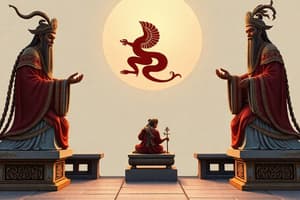Podcast
Questions and Answers
What is the ultimate principle underlying reality in Daoism?
What is the ultimate principle underlying reality in Daoism?
- The Way (Dao) (correct)
- Yin and Yang
- The Three Treasures
- Qi
Which two texts are widely considered key Daoist texts?
Which two texts are widely considered key Daoist texts?
- The Analects and the Mencius
- The Daodejing and the Zhuangzi (correct)
- The Tao Te Ching and the Confucian Analects
- The I Ching and the Tao Te Ching
What are some of the self-cultivation methods in Daoism?
What are some of the self-cultivation methods in Daoism?
- Meditation and internal alchemy (correct)
- Yoga and Pilates
- Prayer and fasting
- Chanting and hymn singing
What do Daoist ethics generally emphasize?
What do Daoist ethics generally emphasize?
What are the roots of Daoism?
What are the roots of Daoism?
What is the first organized form of Daoism?
What is the first organized form of Daoism?
What is the most important center for Daoist monastic training in mainland China?
What is the most important center for Daoist monastic training in mainland China?
What is the main distinction in Daoist cosmology?
What is the main distinction in Daoist cosmology?
What are some key parts of many Daoist traditions?
What are some key parts of many Daoist traditions?
Flashcards
What is the Dao?
What is the Dao?
The fundamental principle of reality in Daoism; a source of everything that embodies naturalness, spontaneity, and simplicity, but not able to be grasped with language or mind.
What is Wu Wei?
What is Wu Wei?
A Daoist concept referring to effortless action or non-action; aligning one's actions with the natural flow of the Dao.
What is Qi?
What is Qi?
A core concept in Daoism representing vital energy that flows through all things; the material force of the universe.
What is Yin & Yang?
What is Yin & Yang?
Signup and view all the flashcards
What was the Way of the Celestial Masters?
What was the Way of the Celestial Masters?
Signup and view all the flashcards
How can Daoist Theology be defined?
How can Daoist Theology be defined?
Signup and view all the flashcards
What are The Three Treasures?
What are The Three Treasures?
Signup and view all the flashcards
What are key elements of Daoist practice?
What are key elements of Daoist practice?
Signup and view all the flashcards
What are some common Daoist rituals?
What are some common Daoist rituals?
Signup and view all the flashcards
Study Notes
Taoism is a Chinese tradition and religion that stresses living in harmony with the Dao or Way, which is defined as the source of everything and the ultimate principle underlying reality.
The Daodejing and the Zhuangzi are widely considered key Daoist texts.
Daoism includes various self-cultivation methods, including meditation, internal alchemy, and various rituals.
Daoist ethics vary depending on the particular school but generally emphasize virtues like "non-action," "naturalness," and "simplicity."
The roots of Daoism go back at least to the 4th century BCE and drew cosmological notions from the School of Yinyang and other influences such as Shang and Zhou dynasty religion, Mohism, Confucianism, Legalist theorists, and the Chinese classics.
Daoism has had a profound influence on Chinese culture and has been associated with Chinese alchemy, astrology, martial arts, traditional medicine, feng shui, and many styles of Qigong.
Today, Daoism is one of the five religious doctrines officially recognized by the People's Republic of China and is a major religion in Taiwan and throughout the Sinosphere.
Daoism is also practiced in other societies throughout East and Southeast Asia, particularly in Malaysia, Singapore, and Vietnam, as well as by Western convert Daoists.
The word Daoism is used to translate different Chinese terms, and there is a distinction between Daoist philosophy and religion, although scholars disagree on the nature of Daoist religion.
The early Daoism was a series of "inner-cultivation lineages" of master-disciple communities that emphasized a contentless and non-conceptual apophatic meditation as a way of achieving union with the Dao.
By the Han dynasty, the various sources of Daoism had coalesced into a coherent tradition of ritualists in the state of Shu, and the first organized form of Daoism was the Way of the Celestial Masters.A Brief History of Daoism in China
-
The "Way of Great Peace" movement in Shandong sought to replace the Han dynasty and led to the Yellow Turban Rebellion.
-
The Celestial Masters movement survived and became an influential religion during the Three Kingdoms period, focusing on ritual confession and petition.
-
Taiqing was an important early Daoist movement focused on external alchemy and seeking immortality through elixirs.
-
The Xuanxue tradition arose during the Three Kingdoms period and integrated Confucian teachings with Daoist thought.
-
The Six Dynasties era saw the rise of the Shangqing and Lingbao traditions, which focused on scriptural recitation and talisman use for harmony and longevity.
-
The Northern Celestial Masters established the first Daoist monastic institution in the Zhongnan mountains.
-
Lu Xiujing developed the "three caverns" schema to unify Daoist traditions and compiled the first edition of the Daozang.
-
The Quanzhen School was founded in the 12th century and became the largest and most important Daoist school in China.
-
The Jingming school merged Daoism with Buddhist and Confucian teachings and focused on practical ethics and self-cultivation in everyday life.
-
During the Cultural Revolution, many Daoist priests were persecuted, and many Daoist sites and temples were destroyed or converted to secular use.
-
The 20th century saw the development of Tai Chi and the surge in popularity of Qigong practice.
-
Today, Daoism is one of five officially recognized religions in the People's Republic of China and is regulated by the Chinese Taoist Association.Overview of Daoism and its Spread
-
The White Cloud Temple in Beijing is the most important center for Daoist monastic training in mainland China, while the five sacred mountains of China also contain influential Daoist centers.
-
Daoism is also practiced in Taiwan and Hong Kong, where it is a major religion and retains unique features and movements which differ from mainland Daoism.
-
Daoism is a diverse "world religion" with a global distribution, spreading through Chinese emigration and conversion by non-Chinese.
-
Daoist influenced practices like Tai Chi and Qigong are popular around the world.
-
Daoism began to spread to the Western world in the late 20th century, with various forms of Daoist communities, Daoist publications, websites, meditation and Tai chi centers, and translations of Daoist texts by western scholars as well as non-specialists.
-
Popular Western Daoism is associated with popular translations and interpretations of the Daodejing and the work of popular figures like James Legge, Alan Watts, John Blofeld, Gia-fu Feng, and Bruce Lee.
-
Traditional-minded Daoists in the West are often either ethnically Chinese or generally assume some level of sinification, especially the adoption of Chinese language and culture.
-
Western convert Daoist groups are led either by Chinese teachers or by teachers who studied with Chinese teachers.
-
Popular in the West are groups which focus on internal martial arts like Taijiquan, Qigong and meditation.
-
Daoist philosophy holds that the universe works harmoniously according to its own ways, and one must place their will in harmony with the natural way of the universe.
-
The Daoist view of the self is a holistic one, which rejects the idea of a separate individualized self.
-
Many Daoist practices work with ancient Chinese understandings of the body, its organs and parts, "elixir fields" (dantien), inner substances (such as "essence" or jing), animating forces (like the hun and po) and meridians (qi channels).Overview of Daoism
-
Daoism is a Chinese philosophical and religious tradition that emphasizes simplicity, naturalness, and the Way (Dao) as the fundamental principle of reality.
-
The concept of qi (vital energy) is central to Daoist beliefs and practices, and is seen as the material force of the universe.
-
Daoist ethics emphasize naturalness, spontaneity, simplicity, detachment from desires, and wu wei (effortless action).
-
The Three Treasures (jīng, qì, and shén) are central to Daoist physical practices like qigong and neidan.
-
Daoists have diverse religious goals which include sagehood, spiritual self-cultivation, a happy afterlife, longevity, and some form of immortality.
-
Daoist cosmology is cyclic, with the universe in constant change and various forces and energies (qi) affecting each other in different complex patterns.
-
The main distinction in Daoist cosmology is between yin and yang, which applies to various sets of complementary ideas.
-
Daoist theology can be defined as apophatic, given its philosophical emphasis on the formlessness and unknowable nature of the Dao.
-
Key elements of Daoist practice include self-cultivation, wu wei, and attunement to the patterns of the Dao.
-
Daoist rituals involve presenting offerings, scripture reading, sacrifices, incantations, purification rites, confession, petitions and announcements to the gods, observing the ethical precepts, memorials, chanting, lectures, and communal feasts.
-
Daoist ethical precepts include avoiding killing, theft, sexual misconduct, lying, intoxicants, and five injuctions.
-
Divination and magic are also key parts of many Daoist traditions.
Studying That Suits You
Use AI to generate personalized quizzes and flashcards to suit your learning preferences.




